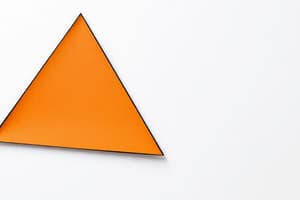Podcast
Questions and Answers
What defines an acute triangle?
What defines an acute triangle?
- It has one angle equal to 90 degrees.
- It has two angles greater than 45 degrees.
- It has three angles all less than 90 degrees. (correct)
- It has one angle greater than 90 degrees.
Which of the following is true about obtuse triangles?
Which of the following is true about obtuse triangles?
- It can also be classified as a right-angled triangle.
- It contains one angle that is greater than 90 degrees. (correct)
- All angles must be less than 90 degrees.
- All angles are equal to 60 degrees.
In a right-angled triangle, which angle measurement is guaranteed?
In a right-angled triangle, which angle measurement is guaranteed?
- One angle measuring 45 degrees.
- One angle measuring exactly 90 degrees. (correct)
- No angles greater than 90 degrees.
- All angles measuring less than 60 degrees.
Can a triangle be classified as both acute and obtuse?
Can a triangle be classified as both acute and obtuse?
How many sides does a triangle have?
How many sides does a triangle have?
When classifying triangles, which characteristic can be used?
When classifying triangles, which characteristic can be used?
In what scenario would a triangle have angles measuring 30°, 60° and 90°?
In what scenario would a triangle have angles measuring 30°, 60° and 90°?
What is required to ensure the sum of angles in a triangle?
What is required to ensure the sum of angles in a triangle?
What is the correct relationship between the exterior angle of a triangle and the two non-adjacent interior angles?
What is the correct relationship between the exterior angle of a triangle and the two non-adjacent interior angles?
If a triangle has one angle measuring 90°, which of the following statements is true?
If a triangle has one angle measuring 90°, which of the following statements is true?
In a triangle, if two angles measure 42° and 58°, what can be concluded about the third angle?
In a triangle, if two angles measure 42° and 58°, what can be concluded about the third angle?
What can be inferred about the sum of the angles in a triangle as compared to the angles in a rectangle?
What can be inferred about the sum of the angles in a triangle as compared to the angles in a rectangle?
What does folding the angles of a triangle inward and having the vertices touch each other demonstrate?
What does folding the angles of a triangle inward and having the vertices touch each other demonstrate?
Flashcards are hidden until you start studying
Study Notes
Classifying Triangles
- Triangles can be classified based on their side lengths or angle measures.
- Acute Triangle: All angles are less than 90 degrees.
- Obtuse Triangle: One angle is greater than 90 degrees.
- Right Angled Triangle: One angle is 90 degrees.
- A triangle can only be classified as one type at a time, as the angle measures determine its classification.
Interior Angles of a Triangle
- The sum of the three interior angles of any triangle is always 180 degrees.
- You can measure the angles of a triangle using a protractor and record the findings in a table.
- This rule can be demonstrated by cutting out a triangle, folding the angles inward, so the vertices touch, or by ripping off the corners of the triangle and arranging them to form a straight line.
Exterior Angles of a Triangle
- An exterior angle of a triangle is formed by extending one side of the triangle.
- The measure of an exterior angle is equal to the sum of the two non-adjacent interior angles.
Relating Triangle and Rectangle Angle Properties
- The sum of the interior angles of a triangle (180 degrees) is half the sum of the interior angles of a rectangle (360 degrees). This is because a rectangle can be divided into two congruent right-angled triangles.
Determining Unknown Angles
- To find the measure of an unknown angle in a triangle, you can use the fact that the sum of the interior angles is 180 degrees.
- You can also use knowledge of angles on a straight line (180 degrees) to find the measure of an adjacent angle.
Studying That Suits You
Use AI to generate personalized quizzes and flashcards to suit your learning preferences.




